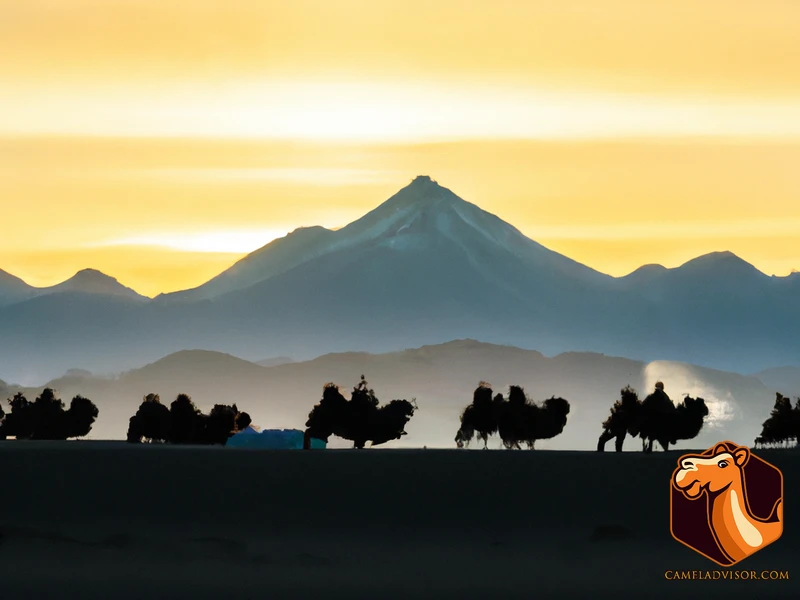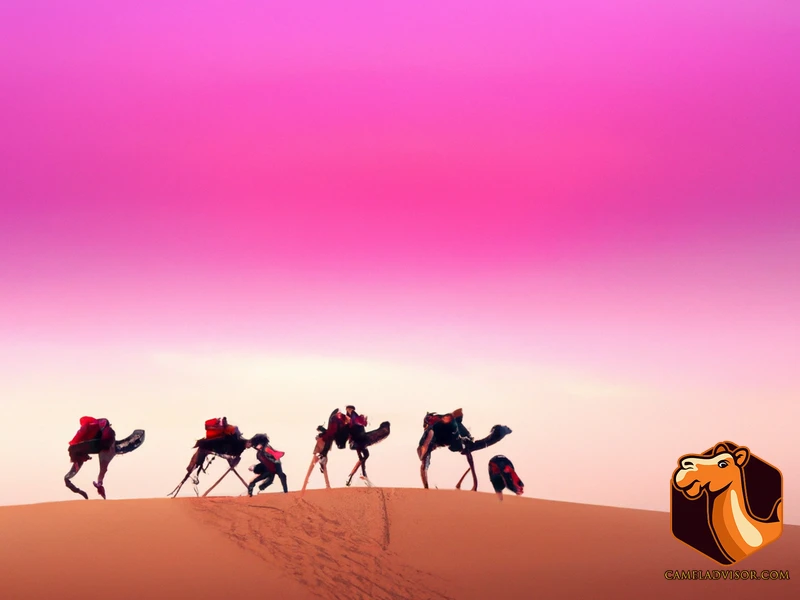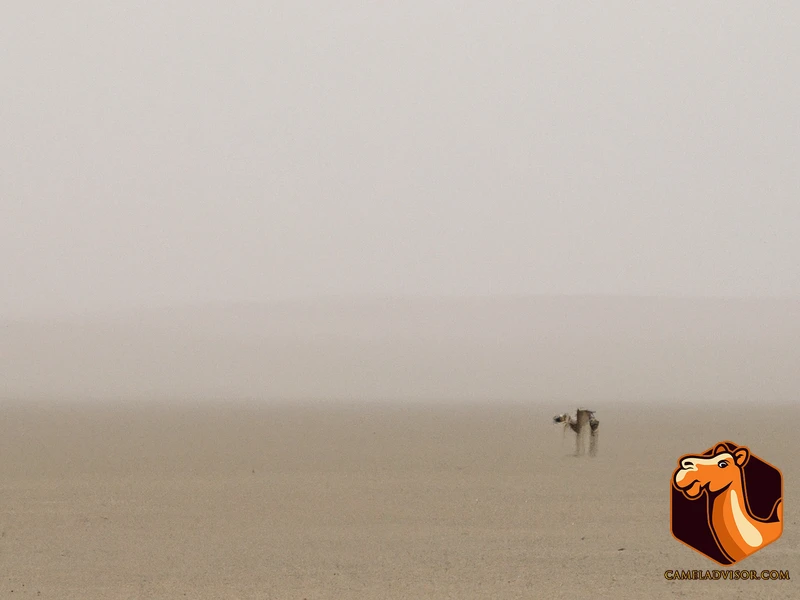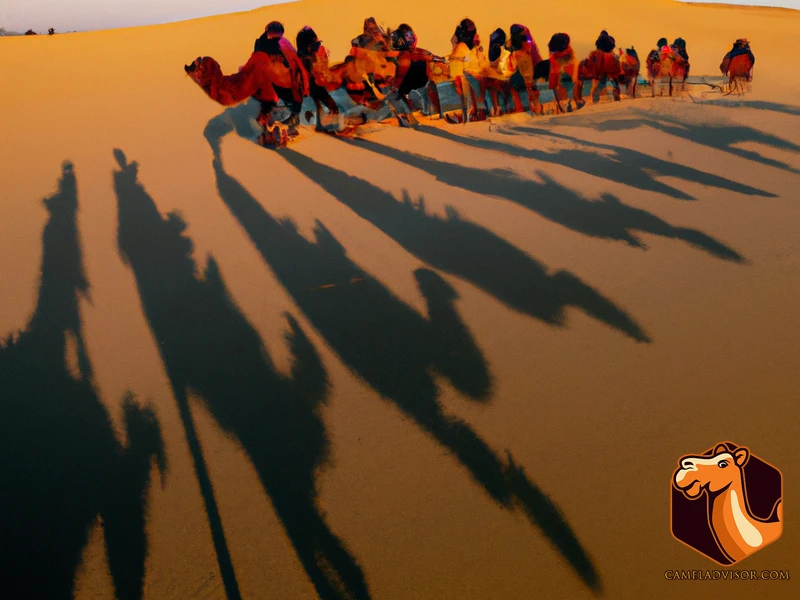The Silk Road, one of the world’s most legendary trading routes, has captured the imagination of historians, travelers, and adventurers for centuries. Although much of the route was traversed on foot, the use of camels proved to be a crucial factor in the success of the Silk Road trade. These beasts of burden made it possible to transport goods over long distances, through harsh terrain, and across cultural and linguistic barriers. But exactly how did camels come to play such a vital role in the Silk Road? And what other roles did these fascinating animals play along the way? In this article, we will explore the importance of camels in the Silk Road trade and their lasting impact on the world.
Contents
- The Beginning of the Silk Road Trade
- Camel Caravans in Silk Road Trade
- Cargo Transport by Camels
- Ancillary Role of Camels in the Silk Road Trade
- Decline of the Camel’s Significance
- Revival of Camels in the Modern World
- Conclusion
-
Frequently Asked Questions
- What is the Silk Road?
- Why are camels important in the Silk Road trade?
- Where did the Silk Road originate?
- What was the main purpose of the Silk Road?
- How did camels adapt to the harsh desert terrain along the Silk Road?
- What types of goods were transported by camels on the Silk Road?
- What was the impact of camels on warfare during the Silk Road era?
- How did camels contribute to cultural exchange along the Silk Road?
- When did the significance of camels decline on the Silk Road trade?
- Why have camels made a resurgence in the modern world?
- References
The Beginning of the Silk Road Trade

The Silk Road trade was one of the most significant historical events that took place on the Eurasian continent. It was a vast network of trade routes that connected the East and West, allowing for the exchange of goods, ideas, and cultures. The origins of the Silk Road can be traced back to the ancient empires of China and Rome, who sought to expand their trading horizons. However, the harsh desert terrain of Central Asia posed a daunting challenge to traders. It was here that camels became a vital part of Silk Road trade, and the history of this trade cannot be told without acknowledging the crucial role camels played. Let’s delve deeper into the story of camels in the Silk Road trade.
How Camels Became Vital in the Silk Road
Camels became vital in the Silk Road trade due to their unique ability to survive and thrive in the harsh desert terrain that dominated the trade route. Their ability to survive long periods without water and food made them the perfect mode of transportation for traders who wanted to traverse the vast deserts of Central Asia.
Camels’ significance in Silk Road trade can be attributed to several reasons:
- Adaptability to Desert Life: Unlike horses and other pack animals, camels were capable of surviving in the harsh desert environment, thanks to their unique physiology, which allows them to conserve water and withstand extreme temperatures. This adaptability made them the primary mode of transportation for traders, caravans and armies in the desert.You can learn more about camel trading routes in the Middle East here.
- Efficiency and Speed : Camels are capable of carrying heavy loads long distances with minimal rest, making them ideal for Silk Road trade where commodities were transported over long distances. Camel caravans could travel up to 30 miles per day, covering distances of several hundred miles in a single journey. Unlike other pack animals, camels don’t need grazing pastures, and they can feed on any type of vegetation found in the desert, which eliminates the need for specialized care and food.
- Reliability: The Silk Road trade thrived on reliability, and camels were regarded as the most reliable transportation mode. Camels rarely fell ill or suffered from fatigue, and their ability to navigate through the desert terrain made them preferable to horses and donkeys. Additionally, their docile nature and better temperament made them less susceptible to panic and more adapted to the harsh conditions of the desert.
Camels quickly became the backbone of the Silk Road trade, connecting China to Europe and the Middle East. Merchants and traders frequently used camel caravans to transport silk, spices, and precious metals across the vast desert expanse of Central Asia, where weather conditions were extreme and unforgiving. One of the most famous camel caravans was the Saharan caravan, which transported salt across the Sahara desert for centuries. You can read more about famous camel caravans in the Sahara here.
In addition to trade, camels played an essential role in many aspects of life along the Silk Road. For instance, the royal camel corps was an integral part of the ancient military that relied on camels to transport troops and provisions during maneuvers. You can read about the history of royal camel corps here. Camels also played a significant role in cultural exchange between different civilizations as it allowed traders, scholars, and adventurers to travel long distances and interact with new cultures. You can learn more about the role of camels in Bedouin culture here.
The camel’s contribution to the Silk Road trade cannot be overemphasized. They helped create a vast network of trade and cultural exchange that spanned much of Central and Southern Asia. Even today, the significance of the camel endures in various parts of the world, with countries like Saudi Arabia organizing annual camel races that highlight the close relationship between camels and humans. Learn more about the Saudi Camel Races Heritage here or the story of Al Mourtajez, a racing camel, here. Camels are also being used in modern explorations of the Australian outback, you can read more about their use here.
Camel Caravans in Silk Road Trade
The Silk Road trade route was not only a network of valuable trade connections, but it also fostered remarkable cultural and intellectual exchanges. The Silk Road was traveled by many caravans, but none was as recognizable and vital to the route’s success as the camel caravans. The use of camels revolutionized trade along the Silk Road and played a significant role in establishing a prosperous commercial system across vast deserts and snow-capped mountain ranges. In this section, we will explore the remarkable influence of these humpbacked creatures in the flourishing trade of the Silk Road.
How Camels Performed in the Harsh Desert Terrain
Camels were particularly suited for transport in the harsh desert terrain of the Silk Road. They possessed certain adaptations that allowed them to withstand the hostile conditions of the desert.
1. Water Storage
One of the most important adaptations of camels was their ability to store large amounts of water in their bodies. They could survive for long periods without water, which was vital in the arid and harsh climate of the Silk Road. This allowed traders to travel long distances without worrying about running out of water.
2. Tough Feet
Camels’ feet were perfectly suited for walking on the rough desert terrain. Their tough, thick footpads spread out when they stepped, providing excellent traction in the sand. They could also tolerate rocky and jagged terrain, which made them ideal for the desert of the Silk Road.
3. Efficient Locomotion
Camels have a unique style of walking known as “pacing.” This type of locomotion involves moving their left and right legs on the same side of their body at the same time. This ensured that their movement was smooth and efficient, even on the harshest terrain.
4. Resistance to Heat
The extreme desert heat was no match for the camel’s thick fur coat. It provided insulation and protected them from the blazing sun. They could also close their nostrils to prevent sand from entering their noses, and their eyebrows blocked sand and dust from their eyes.
5. Minimal Need for Food
Camels are known for their ability to survive without food for long periods. They could also eat thorny desert vegetation that other animals could not. This meant that they did not require constant grazing and could travel long distances without stopping to eat.
Camels were critical to the Silk Road and its trade because their unique adaptations allowed them to transport goods across harsh desert terrain with ease.
Cargo Transport by Camels

As the Silk Road trade continued to flourish, the need for efficient and reliable transportation of goods became increasingly important. With the vast and treacherous landscapes of the Silk Road, camels played a crucial role in the transport of cargo. The use of these hardy animals revolutionized the trade industry and allowed for the transportation of larger quantities of goods over greater distances. Let’s explore the fascinating role that camels played in cargo transport along the Silk Road.
Types of Goods Transported by Camels
Camels played a crucial role in the transportation of goods along the Silk Road. Due to their ability to cover long distances while carrying heavy loads, they were the preferred mode of transport for merchants. The types of goods transported by camels on the Silk Road were diverse and ranged from luxury goods to everyday necessities.
Luxury Goods: Precious gems, rare spices, and exotic perfumes were among the luxury goods transported by camels. These valuable items were carefully packed and carried by the camels to be sold to rich and powerful rulers along the Silk Road.
Textiles: Silk, of course, was the most famous of all the textiles transported by camels on the Silk Road. However, other textiles such as cotton and wool were also transported. The camels, with their sturdy backs and long legs, were able to carry large quantities of textiles from one end of the Silk Road to the other.
Food and Beverages: Camels were also used to transport food and beverages such as tea, dried fruits, nuts, and grains. These items were essential for sustaining the travelers and merchants who journeyed along the Silk Road. Camels were able to carry large quantities of food, making them the perfect mode of transport for traders.
Metal Goods: Equipment made of metal such as swords, armor, and tools were also transported by camels. These metal goods were often in great demand, particularly among the soldiers who traveled along the Silk Road.
Camels were vital in the transportation of goods on the Silk Road, and without them, the trade that took place along this route would not have been possible.
Ancillary Role of Camels in the Silk Road Trade
While the primary role of camels in the Silk Road was as beasts of burden, their impact on the trade route was not limited to cargo transport. In fact, these magnificent animals played an ancillary role in several other aspects of the Silk Road trade that went beyond their physical capabilities. From their involvement in warfare to their contribution to cultural exchange, the multifaceted role of camels in the ancient trade network is a fascinating subject to explore. Let’s take a closer look.
Camels in Warfare
Camels played a crucial role in warfare during the Silk Road era. They were used as a form of cavalry due to their strength, endurance, and ability to navigate through the desert terrain with ease. Here are some ways in which camels were used in warfare:
- Camel Cavalry: Camels were used as a form of cavalry in some armies due to their speed and combat abilities. Soldiers would ride on the back of the camel and use their spears, bows, or other weapons to attack the enemy. Camel cavalry units were particularly effective in desert regions, where conventional horse cavalry struggled to maneuver.
- Transport: Camels weren’t just used for mounted combat, but also played a crucial role in transporting military supplies and even wounded soldiers. Camels’ ability to carry heavy loads for long distances through harsh terrain made them ideal for this purpose.
- Intimidation: Camels were also used to intimidate enemy soldiers. Due to their size, camels can be quite intimidating, especially if they are unaccustomed to the smell and sound of the animals. It was not uncommon for soldiers to use camels to charge at enemy lines, generating panic among the enemy forces.
While camels were certainly useful for warfare during the Silk Road era, their significance gradually declined with the arrival of more advanced modes of transportation, such as trains and automobiles. However, even today, some armies continue to use camels in certain regions where other modes of transportation would prove less effective.
Camels in Cultural Exchange
Camels played an important role not only in the economy, but also in cultural exchange along the Silk Road. As the caravans traveled through different regions, they carried not only goods but also ideas, technologies, and religions from one culture to another. Camels were often used to transport scholars, artists, and other cultural emissaries who helped to share knowledge and art across borders.
One example of cultural exchange facilitated by camels was the spread of Buddhism from India to China. Buddhist monks and scholars traveled along the Silk Road with their teachings and writings, and often relied on camels to transport them across the harsh terrain. The silk trade also helped to spread Buddhism, as silk was an important gift given to Buddhist temples and monasteries by wealthy patrons.
Another cultural exchange facilitated by camels was the spread of paper-making technology from China to the west. It is believed that the first paper mills were established in China and then spread along the Silk Road to other parts of the world. Camels were used to transport the paper and the knowledge of how to make it.
Camels were also used to transport cultural artifacts and treasures, such as pottery, textiles, and artwork. Many of these artifacts can be seen in museums around the world today, and are a testament to the role that camels played in the transmission of culture along the Silk Road.
| Cultural Exchange Facilitated by Camels | Example |
|---|---|
| Religion | The spread of Buddhism from India to China |
| Technology | The spread of paper-making technology from China to the west |
| Artifacts and Treasures | The transport of pottery, textiles, and artwork |
Camels were an important vehicle for cultural exchange along the Silk Road, carrying not just goods but also ideas, technologies, and religion. They helped to connect people of different cultures and fostered an environment of learning and innovation. Even today, their legacy lives on in the artifacts and ideas that were transported along the Silk Road.
Decline of the Camel’s Significance

As time passed, new modes of transportation began to emerge, which resulted in a decline in the significance of camels for Silk Road trade. The introduction of safer sea routes and the development of more advanced methods of land transportation, such as trains and trucks, gradually reduced the need for camels. With the establishment of more stable and secure nations along the Silk Road, the risks of banditry and theft decreased, further reducing the need for camels’ unique nomadic properties.
Additionally, as civilization progressed, people gradually become more reliant on machines and technology to ease their labor, creating a decline in the need for manual labor like camel caravans. As a result, camels lost their once-crucial role in Silk Road trade, and their population suffered harshly.
The decline of camels’ significance had far-reaching consequences for both trade and transportation in the Silk Road region. The decline of camel caravans was a significant loss for smaller, more distant communities, which depended on the Silk Road for essential goods. The decrease in camel breeding ultimately caused a loss of a lifestyle and had a negative impact on animal welfare as well.
Despite these changes, camels’ significance in the cultural and historical context of the Silk Road cannot be ignored. They still hold a special role in the traditions, arts, and cuisine of Silk Road regions, which serve to preserve their legacy.
Revival of Camels in the Modern World
In modern times, camels are still used for transportation in certain parts of the world. In fact, some countries have even begun to revive the use of camels in their economies. The United Arab Emirates, for example, has invested heavily in promoting camel racing as a tourist attraction. The races, which feature specially bred and trained camels ridden by jockeys, can offer large payouts to winners and are often accompanied by cultural events and markets.
Additionally, the global demand for camel milk has increased in recent years. Camel milk is said to have health benefits such as aiding in digestion and boosting the immune system. As a result, countries such as Australia and the United States have begun to import and produce camel milk, creating a new industry for camel herders.
Camels have also gained popularity as a recreational activity. Camel safaris in desert areas such as Dubai and Morocco have become popular tourist attractions, offering visitors a chance to experience the traditional mode of transportation along the Silk Road. These tours often provide a glimpse into the life of camel herders and their role in desert communities.
While the use of camels as a primary mode of transportation along the Silk Road may have declined, their significance in modern times has not been completely forgotten. The animal has found new roles in economies, recreation, and even health, proving its versatility and impact on societies throughout history.
Conclusion
In conclusion, we can see that the role of camels in the Silk Road cannot be overstated. These creatures played a pivotal role in the success of trade along this historical route. They were well-equipped to traverse the challenging terrain of the Silk Road and could carry large amounts of cargo with relative ease.
Moreover, they provided ancillary support for various other uses, such as being utilized in warfare and cultural exchange. The decline of the importance of camels, however, began with the advent of motorized vehicles that made transport along the Silk Road faster and more efficient, relegating camels to a minor role.
Despite this, the revival of camels in the modern world is promising, with many tourists seeking out camel tours through the old Silk Road. This resurgence is a testament to the enduring legacy of these magnificent creatures and the important role they played in global trade and cultural exchange.
Overall, the role of camels in the Silk Road is one of great historical significance, and we must continue to remember and appreciate their contribution to the world we live in today.
Frequently Asked Questions
What is the Silk Road?
The Silk Road was a network of trade routes connecting the East and West, spanning from China to the Mediterranean Sea.
Why are camels important in the Silk Road trade?
Camels were the primary mode of transportation for goods and people across the vast deserts along the Silk Road.
Where did the Silk Road originate?
The Silk Road originated in China during the Han Dynasty.
What was the main purpose of the Silk Road?
The main purpose of the Silk Road was to facilitate trade and cultural exchange between the East and West.
How did camels adapt to the harsh desert terrain along the Silk Road?
Camels adapted to the harsh desert terrain by having thick fur and the ability to store water, making them capable of long journeys in the hot, arid climate.
What types of goods were transported by camels on the Silk Road?
Camels transported a wide range of goods such as silk, porcelain, spices, precious metals, and religious artifacts.
What was the impact of camels on warfare during the Silk Road era?
Camels were used in warfare to transport soldiers and supplies across the harsh desert terrain and were also used as a form of biological warfare by spreading disease.
How did camels contribute to cultural exchange along the Silk Road?
Camels contributed to cultural exchange by carrying religious artifacts, art, and literature across the Silk Road and introducing new ideas to different societies.
When did the significance of camels decline on the Silk Road trade?
The significance of camels on the Silk Road trade declined with the development of new forms of transportation such as trains and ships in the modern era.
Why have camels made a resurgence in the modern world?
Camels have made a resurgence in the modern world due to their ability to survive in harsh environments, making them valuable for tourism and transportation in certain regions.







